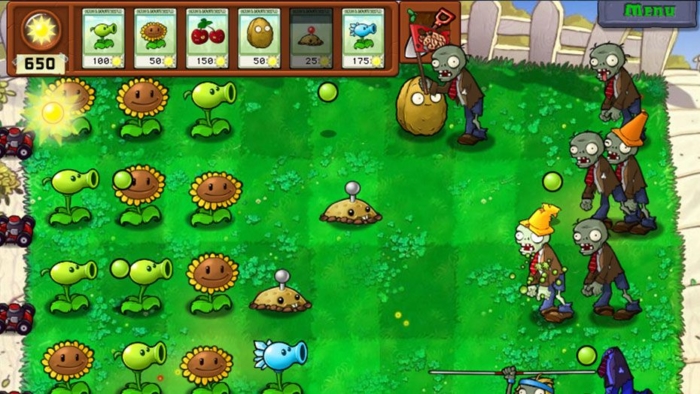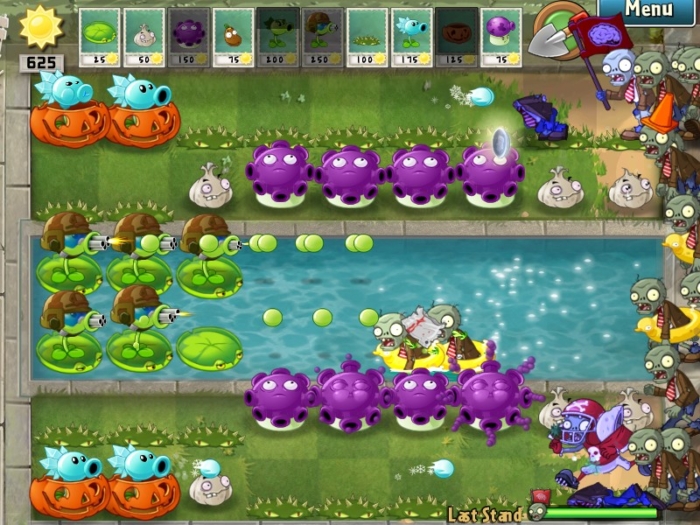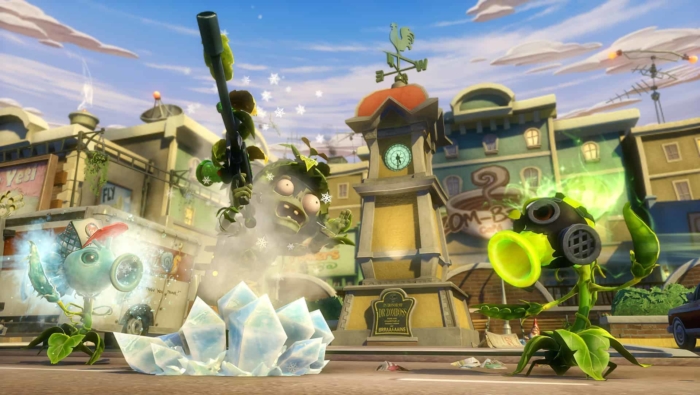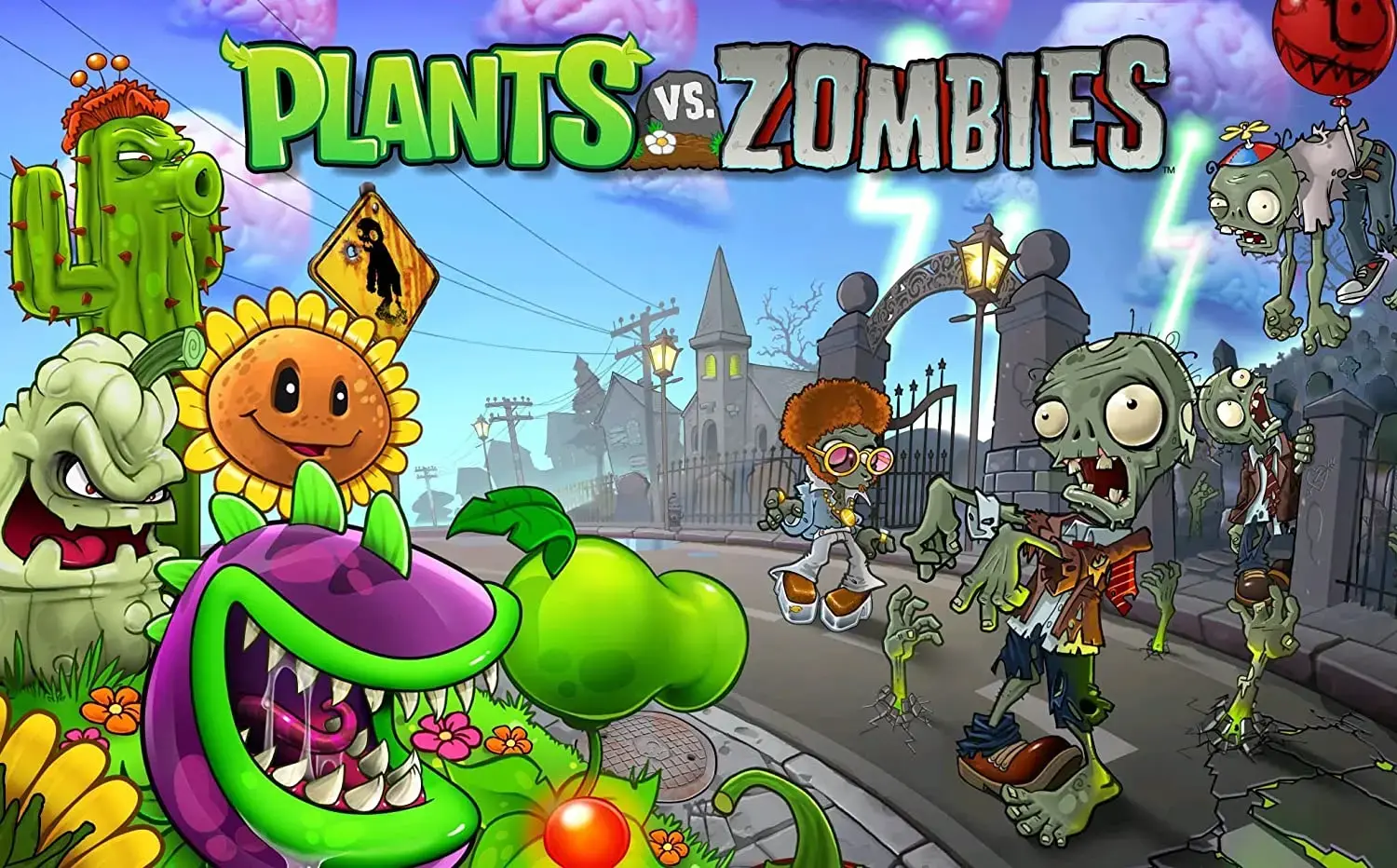Story of a Game: Plants vs. Zombies
Games have stories. Not just stories of how they were developed, but stories from the people that played them and the way they affected the gaming world.
In this series, Ultimate Gaming Paradise is going to bring you some of the stories of games, from headline-making triple-A titles to some indie masterpieces.
Pack some fertiliser, get out the suncream, and prepare for the apocalypse. It’s Plants vs. Zombies!
An Absorbing Strategy Game Genre
In 2007, tower defence was booming. A new strategy subgenre of computer games, it had been borne from origins such as Space Invaders (1978), Rampart (1990), and the strange (and not very fun) Fort Condor mini-game in Final Fantasy VII (1997), but the subgenre itself wasn’t properly named until Warcraft III featured it as a subgame.
At the time, tower defence was the province of the invested gamer. It could be complicated, requiring the player to keep an eye on a host of resources and make sense of myriad tiny icons, while filling screens with high-tech looking buildings shooting a variety of lasers and projectiles as small units of soldiers poured out of spawning stations. To the uninitiated, it was a brain-melting mess of quick decisions and frustrating failures. To the devoted, it was an incredibly addictive way to spend an afternoon.
George Fan was a devotee.
During the early days of Fan’s career, he had managed to get himself noticed with a virtual fish tank game called Insaniquarium and had landed a job at Blizzard working on the RPG title Diablo III. Blizzard and Fan were a poor match, with George fancying himself more of a designer than a programmer and Blizzard not really being interested in his designs. Consequently, he left to go freelance.
It was Blizzard’s game Warcraft III, however, that inspired Fan. The tower defence side game and all the fan-made mods that went with it were occupying a large chunk of his free time and soon he began to wonder if there were ways to take his fish tank designs from Insaniquarium and turn them into a tower defence game.
Tower Defence For Everyone
Fan wanted to make a tower defence title that stripped away some of the more complex aspects of the games he had been playing. Strongly independent as a designer, he loved the idea of casual and indie games that could be played by people who didn’t have the time investment it took to learn the complex systems of Warcraft III tower defence. It had to be friendly and it had to be fun.
What if the fish were the towers, and some aliens were on course to wipe them out?
From Fish to Plants
The fishtank vs. aliens project wasn’t the only thing on George Fan’s mind. He was also dabbling with a gardening game idea, enjoying the relaxing nature of planting plants and watching them grow. Over time, the two began to merge.
One of the problems with tower defence games, he had determined, was with the spurious logic of its soldiers. One day, as he whiled away the time playing yet more fantasy-based strategy, he watched as his little knights chased an army of orcs away from their barracks. Then he watched as the orc escaped, having reached the edge of the knights’ defined zone. The armoured defenders simply turned and walked back to their home, letting the invader getaway.

It irked him. Why didn’t the knight follow the orc and chop him down? He had the advantage and it would be one less bad guy to have to kill later. It made no sense that the knight simply gave up because he’d reached an imaginary line marking the distance between him and the barracks.
In his game, there wouldn’t be any moments like that. In his game, it would make sense.
His defenders had to not move. That way, they’d never be put in the position of having to give up the chase—there’d never been a chase in the first place.
It wasn’t long before the fish were out, and the plants from his gardening game were in. After all, no one ever expected a plant to move from its location.
Bye Bye Aliens, Hello Zombies
Plants vs. Aliens was looking to be a fun game, but there was a new problem—one of originality.
George Fan was keen for his games to be original and quirky and aliens weren’t doing the right thing for him. What could he have instead?
He soon realised that he needed something that moved slowly. This was to be a casual game and he wanted to give the player enough time to think and consider their strategy, not just overrun them with speedy enemies that cross the screen in seconds. Early on, he’d made the decision to have the gameplay on a single screen—another nod to simplicity and the casual market—so there was no functionality to have a great distance between the enemies and the plants. Everything wanted to be big and pretty on-screen; fast attackers would definitely ruin the feel.
Plants vs. Snails was an obvious direction to go—so that was immediately out. What else moves slowly and is a little more whimsical?
Ah yes, zombies.
Developing Plants vs. Zombies
PopCap was the perfect company for Fan. They offered all the support that he and his small team needed, making the process smooth and offering feedback and suggestions when wanted, but never putting the pressure on. It was everything Blizzard hadn’t been.
The PvZ team was four: George Fan himself; his friend, artist Rich Warner; the programmer, Tod Semple; and up-and-coming game music composer, Laura Shigihara.
It took them three and a half years.
“If we wanted to, we could have released Plants vs. Zombies two and a half years into it; we spent a whole year polishing the game…” – George Fan, 10th Anniversary Interview with ZackScottGames.
It’s that attention to detail and polish that really makes Plants vs. Zombies stand out. Take it away, and perhaps what would have resulted would have never made it into people’s hearts, but PopCap made the right decision and allowed Fan and his team the freedom to get the game out when it was ready, and not a moment before—something many game developers today could only wish for.
One of the First iOS Games
When Plants vs. Zombies was in development, there was no such thing as an iPhone. The idea of a small touchscreen computer in your pocket wasn’t even a consideration for the team, but when it happened, they knew it was important. Plants vs. Zombies, alongside titles like Angry Birds and Doodle Jump, was one of the first significant game titles for Apple’s new device. A quirk of fate that would boost its success manifold.
The game had already been developed (with the PC as its main market) to be played on a single screen. It had bright and colourful, friendly graphics. It had a simple interface that could be easily translated from a mouse to a finger on a touchscreen. It had everything it needed.
It made even more impact in the fledgling iPad market a little later. Some of the earliest adopters for iPads were celebrities, keen to show that they were up-to-date with the latest technology. And what did those celebrities do with their new tablets? They played PvZ.
Even before the idea of ‘influencer’ had seeped into the culture, the first influencers were unconsciously telling people to go out and get this game—and get it they did.
Such was the impact of Plants vs. Zombies that its graphical style was copied by a huge number of other games looking to make it on the new mobile devices. It led to a situation where people think of the graphics of PvZ as being “mobile-game-like”. They’re not, it’s the other way around—mobile games look like copies of Rich Warner graphics!
The Zombies Are Coming!
Everyone played Plants vs. Zombies.
For those who were already a fan of tower defence games, PvZ represented a guilty pleasure—a game you were determined not to really like (after all, it was cut back tower defence, developed for the casual market), but once played, the sheer brilliance of the gameplay coupled with that aforementioned polish, meant that Plants vs. Zombies was worthy of multiple playthroughs (and often, on multiple platforms). One game was never enough and working out crazy strategies (“I’m going to complete this next level using just wall-nuts and the spiky floor”) was part of the challenge. Soon, any sign of prejudice was dismissed and the most hardcore tower defence and strategy players declared themselves a fan.

Those who were casual gamers, the kind who would pop in and pop out of a game for ten minutes just looking for a distraction, found more than they bargained with when they downloaded Plants vs. Zombies. “Oh, I don’t play computer games,” they’d say, “well, apart from Plants vs. Zombies.”
Gamers played it. Younger siblings played it. Your mum had it on her phone. Plants vs. Zombies was good for everyone, no matter their age.
“But it’s zombies,” someone would say, “isn’t it a little violent for kids?”, and then ten minutes later they’d be hovering behind their six-year-old, reminding them to plant another sunflower as cute and non-threatening-looking cartoon zombies lumbered in from stage left.
Making an addictive game is an achievement. Making an addictive game that can be played anywhere, and appeals to people from five to ninety-five… that’s a success.
There’s a Zombie On Your Lawn
Do be do be do be, do be, do be…
The main tune for PvZ is one of those ear-worm ditties that will never go away. Even now, more than a decade after I first played the game, I will find myself absently humming it in the kitchen.
Laura Shigihara’s music is one of the most recognisable computer game soundtracks of the era and found itself released as a CD in its own right. It’s capped off with the wonderful end credit music (from when you complete the game), a song so sickeningly cute that it’s perfectly wonderful and is the perfect reward for playing your way through all five sections of the main game.
It’s another example of the glistening shine that this game has, a polish that represents at least a year of work for them all. If only all games had the same level of dedication.
The Strange Around and Around Connection With Magic: The Gathering
George Fan was inspired by the trading card game, Magic: the Gathering. He’d been playing his entire life and cites Magic as “the best game ever”. Of course, this in-depth tabletop strategy game influenced him in his design decisions.
It was delightful to see it go the other way around. In 2011, Wizards of the Coast (makers of MtG) released a card called “Grave Bramble” in their Innistrad set. It’s a plant creature, with the ability “protection from zombies”—coincidence? Of course not.
And then, in 2019, George Fan managed to get his dream job—a year-long position working for the design department of Wizard of the Coast, there to create Magic cards of his own.
They couldn’t keep him though—with designing innovative computer games his true passion, his time with WotC was always intended to be temporary.
Sequels and More
My son has a collection of Plants vs. Zombies cuddly toys. There’re a couple of sunflowers, a pea shooter, a repeater, a wall-nut and a cherry bomb and more. On the zombies’ side, there’s cone zombie, the one with a rubber duck, the guy reading the newspaper and others—there’s even a purple-skin zombie for when one of them eats the mushroom. They were cheap enough on eBay and made an excellent present for a young PvZ fan.
While merchandising for computer games is everywhere, there aren’t many games that can support a range of plushies that actually see play, replicating the game state on the living room carpet.
Plants vs. Zombies soon outgrew being a game and entered the arena of being a fully-fledged IP. There was a sequel (with some minor involvement by George Fan, who wanted to go off to do other things and not be stuck as the PvZ guy for the rest of his life), and then another, a spin-off game and even an arcade machine thing. Recently, I found myself walking around as a peashooter defending a neighbourhood from incoming zombies. It felt nothing like the tower defence game that started it all, but it had Plants vs. Zombies on the box (virtually speaking).
From its beginnings as a casual title, spawned from a pet fish simulator and a potential gardening game, Plants vs. Zombies has found its way into every home and taken over.
Except for Crazy Dave’s house of course—we all helped stop that happening. And besides, he’s got lawnmowers.


